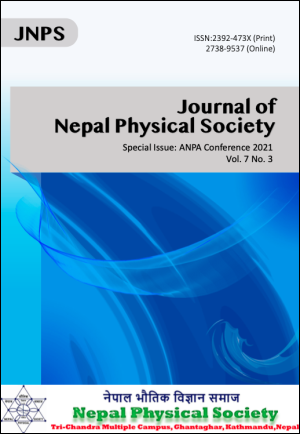Deposition of Reduced Graphene Oxide Thin Film by Spray Pyrolysis Method for Perovskite Solar Cell
DOI:
https://doi.org/10.3126/jnphyssoc.v7i3.42193Keywords:
Titanium dioxide, Reduced graphene oxide, Perovskite solar cellAbstract
The Perovskite absorber layer, the electron transport layer (ETL), the hole transport layer (HTL), and the transparent conducting oxide layer (TCO) are the major components that make up a Perovskite solar cell. Between ETL and HTL, the absorber layer is sandwiched, on which electron-hole pairs are created after absorption of solar radiation. Despite substantial progress toward efficiency, long-term stability still remains a serious concern. Present work focuses toward contributing on the later issue by adopting Titanium dioxide (TiO2) as ETL and reduced graphene oxide (rGO) as HTL. Specifically, in the present work, we report our efforts on the preparation of compact titanium dioxide (C-TiO2) and mesoporous titanium dioxide (M-TiO2) layers as an ETL and a reduced graphene oxide thin film as a HTL. The C-TiO2 film was spin casted on FTO glass followed by casting of M-TiO2 film using Doctor Blading technique. Similarly, the rGO film was produced by spray casting over the glass substrate. The asprepared ETL and HTL layers were characterized by measuring their optical properties (transmittance and reflectance of thin films). Then, the bandgap, Eg was extracted from reflectance and transmittance curves for ETL and HTL respectively. In the case of rGO, we found the value of Eg to be 2.1 eV, which varies between 2.7eV and 0.02eV depending upon its reduction level based on the previously reported values. Similarly, the bandgap of the C-TiO2 was 4.51 eV which was reduced to 4.12 eV after the addition of M-TiO2 , which are 0.9 to 1.1 eV higher than previously reported values. However, bandgap shows decreasing trend after employing M- TiO2 over C-TiO2. In a Perovskite solar cell, both ETL and HTL will be investigated.
Downloads
Downloads
Published
How to Cite
Issue
Section
License
All right reserved. No part of this Journal may be reproduced in any form or by any electronic or mechanical means, including information storage and retrieval system, without permission in writing from the publisher, except by a reviewer who may quote brief passage in a review. The views and interpretation in this journal are those of author(s) and they are not attributable to the NPS.




